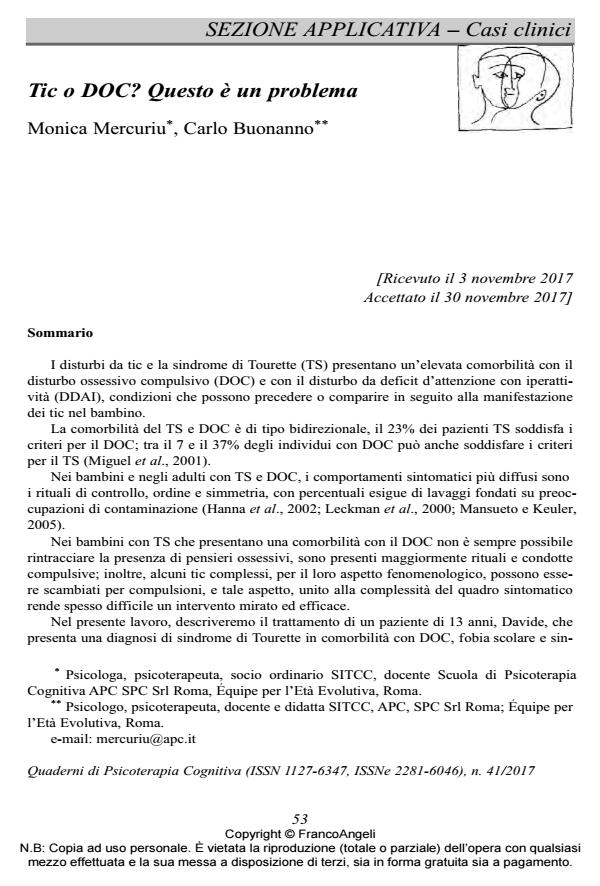Tic or OCD? That is a question
Journal title QUADERNI DI PSICOTERAPIA COGNITIVA
Author/s Monica Mercuriu, Carlo Buonanno
Publishing Year 2017 Issue 2017/41
Language Italian Pages 14 P. 53-66 File size 149 KB
DOI 10.3280/QPC2017-041004
DOI is like a bar code for intellectual property: to have more infomation
click here
Below, you can see the article first page
If you want to buy this article in PDF format, you can do it, following the instructions to buy download credits

FrancoAngeli is member of Publishers International Linking Association, Inc (PILA), a not-for-profit association which run the CrossRef service enabling links to and from online scholarly content.
Tic disorders and Tourette Syndrome (TS) have a high degree of comorbidity with Obsessive Compulsive Disorder (OCD) and Attention Deficit Hyperactivity Disorder (ADHD), conditions that may precede or appear after the tic manifestation in the child. TS and OCD comorbidity is bidirectional, 23% of TS patients meet the criteria for OCD; between 7 and 37% of individuals with OCD can also meet the criteria for TS (Miguel et al., 2001). In children and adults with TS and OCD, the most common symptomatic behaviors are control, order and symptom rituals, with low percentages of washings based on contamination concerns (Hanna et al., 2002; Leckman et al., 2000; Mansueto and Keuler, 2005). In children with TS who exhibit comorbidity with DOC it is not always possible to trace the presence of obsessive thoughts, there are more rituals and compulsive behaviors; More-over, some complex tics, due to their phenomenological aspect, can be exchanged for compulsions, and this aspect, coupled with the complexity of the symptomatic framework, often makes it difficult to implement targeted and effective treatment. In this paper, a 13-year-old patient, David, who has a Tourette Syndrome diagnosis in comorbid OCD, school phobia, and depressive symptoms, will be exposed. The rationale for the intervention, the strategies used and the outcomes of the therapy will be exposed.
Keywords: Tourette Syndrome, chronic tic disorders, exposure with response prevention, obsessive compulsive disorder.
Monica Mercuriu, Carlo Buonanno, Tic o DOC? Questo è un problema in "QUADERNI DI PSICOTERAPIA COGNITIVA" 41/2017, pp 53-66, DOI: 10.3280/QPC2017-041004